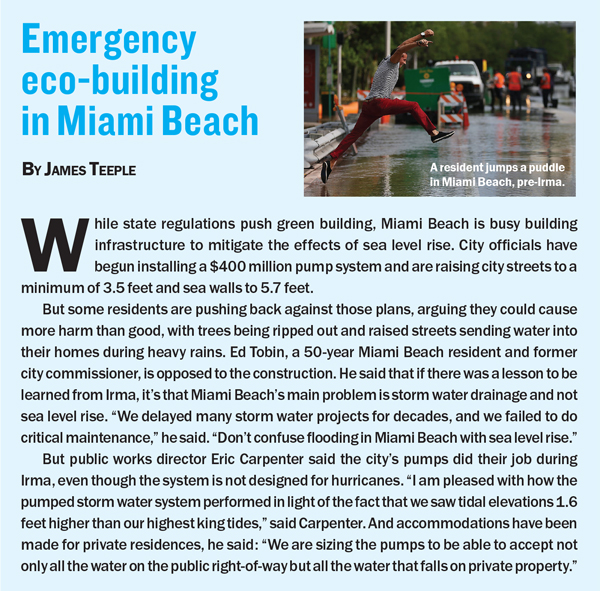If there was ever a time to evaluate the benefits of eco-building, it would be now. While South Florida’s cities were spared the brunt of Hurricane Irma’s full force, many local authorities also credit government-issued building requirements for the region’s relative resilience during the storm. And although post-Irma data wasn’t available at press time, it’s fair to say that the regulations calling for a reduction of the amount of energy and water buildings use have helped to lessen the strain on a storm-ravaged infrastructure.
Many commercial projects go beyond minimum requirements to include eco-features that will create long-term energy cost savings. But on the residential side, expensive eco-products can shrink profit margins and raise listing prices, which deters some potential buyers. Environmentally friendly building can increase both commercial and residential project costs by 1 to 10 percent, experts told TRD.
Large-scale eco-building
In commercial construction, building codes already demand certain levels of resource efficiency, such as LEED certification, which refers to Leadership in Energy & Environmental Design, a widely used rating system devised by the U.S. Green Building Council. Developers also employ other green building programs, such as standards set by the Florida Green Building Coalition (FGBC), a nonprofit that certifies green building projects.
In the city of Miami, for example, new buildings larger than 50,000 square feet must obtain a silver LEED certification, the second in a four-level rating program (certification, silver, gold, platinum). Cost differentials are difficult to determine, but they increase with each step. LEED charges fees for registration, pre-certification and certification, based on the scope of a project.
Developers do the math when they’re deciding how far to go above basic code requirements on new buildings. When they see long-term savings that generate a solid return on investment, they usually opt to spend more on eco-friendly systems, which also help sell the property.
“LEED certification and other green-building certification programs are important marketing tools,” said Brett Porak, director of pre-construction at Fort Lauderdale-based Moss & Associates, a large design and construction firm that has built a range of green projects.
“Some owners and developers follow LEED guidelines without pursuing the actual certification to eliminate the certification cost,” added Ron Antevy, president and CEO of e-Builder, a provider of construction management software headquartered in Fort Lauderdale.
With or without certification, developers stress green elements when marketing their buildings, Antevey said.

“There are currently 1,309 commercial projects participating in LEED in the Miami-Ft. Lauderdale metro area,” said Marisa Long, vice president for public relations and communications for the U.S. Green Building Council. “Of those, 555 are LEED certified. In the state of Florida, there are 3,702 projects participating in LEED,” she said.
Certified or not, the costs are high.
The recently completed Lennar Foundation Medical Center in Coral Gables was built with state-of-the-art green technology for $155 million. It has high-efficiency HVAC and LED lighting systems, high-performance glass that maximizes natural light while reducing cooling and heating loads, fins that reduce solar radiation for many of the windows, and low-flow plumbing fixtures.
The cost per square foot (minus the garage and furniture, fixtures and equipment) was $504, compared to a “straight construction cost” of $402 a square foot — a bit more than a 25 percent increase — according to Ben Riesta, chief administrative officer of the 216,000-square-foot center. The energy reduction is expected to lower annual energy usage by nearly 26 percent compared to a building designed to code-minimum levels of efficiency.
Residential reluctance
Builders are ready to provide green options to residential buyers, but some government regulations will force buyers to pay more for environmentally friendly features whether they want to or not.
South Miami recently became the first Florida city to mandate the installation of solar panels on all new homes. In addition, solar panels must be installed if an owner increases the square footage of an existing home by 75 percent or more. Prices for solar panels in Florida have fallen by 64 percent over the past five years, according to the Solar Energy Industries Association.
Although buyers like the idea of eco-products, they often suffer from a case of sticker shock. “Green options — depending on what you choose — can add between 5 to 10 percent to your cost,” said Jim Traxinger, Florida area president of Kolter Homes. “We don’t push green…It’s a pull, not a push. People in California are happy to save the Earth. In Florida, they want to save a buck,” he said.
At its new Alton community in Palm Beach Gardens, Kolter is building high-end single-family homes offering green features that go well beyond code. Marketing materials for the customizable residences stress “healthy home” systems and materials that reduce indoor moisture, provide a fresh air flow and eliminate pollutants and toxins, along with a variety of other features. Currently, there are 185 homes in the development that have either sold or are under construction. Alton will eventually have a total of 1,344 units.
Even for luxury homes, price is still a major factor in deciding on the green menu. Andrew Zahn, an architect and president of Zahn Development in Fort Lauderdale, built the first LEED-certified home in Broward County in 2009, in the city of Lighthouse Point. “Interest is not as strong [in LEED-certified homes] anymore,” he said. “People want green features but aren’t interested in certification,” he added, saying the reason was the increased cost.
Everything usually comes down to what comes out of buyers’ and builders’ pockets, Zahn said. “It’s mostly about, ‘Will it save money?’”
